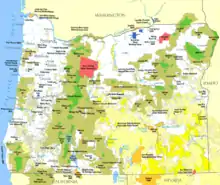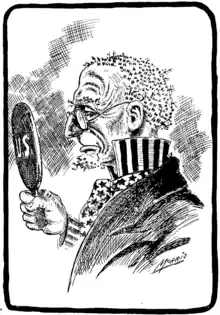Land use in Oregon
Land use in Oregon concerns the evolving set of laws affecting land ownership and its restrictions in the U.S. state of Oregon.

Map of federal land ownership in Oregon
Bureau of Indian Affairs
Bureau of Land Management(BLM)
BLM Wilderness Area
Department of Defense
Fish and Wildlife Service (FWS)
FWS Wilderness Area
Forest Service (FS)
FS Wilderness Area
National Park Service
Timeline
- 1822: Henry Schenck Tanner's map of the U.S. is likely the first to identify the "Oregon Terry."[1]
- 1850: Donation Land Act
- 1851: Willamette Stone sited, became the basis for property lines throughout Oregon and Washington.
- 1862: Homestead Act (in effect till 1976, and 1986 in Alaska)
- October 27, 1868: Corvallis College (now Oregon State University) was designated Oregon's first and only Land Grant College under the federal Morrill Land-Grant Colleges Act.
- 1869: Oregon and California Railroad (O&C) receives land grant from US government with mandate to sell to settlers at $2.50/acre[2]
- 1878: Timber and Stone Act

William Charles Morris cartoon, illustrating the prediction of Secretary of the Interior Gifford Pinchot, who warned U.S. timber resources in the west would be depleted.
- 1903: Southern Pacific Railroad, which acquired the O&C railroad, announces it will no longer sell land, in violation of terms of the land grant[2]
- up to 1905: Abuse of land grant process results in Oregon land fraud scandal[2]
- 1907: Three Arch Rocks first National Wildlife Refuge established west of Mississippi[3]
- 1907: Walter Lafferty begins lawsuit on behalf of 18 western Oregon counties affected by the land fraud scandal
- 1913: public access to beaches formalized—originally for use as highways—codified general public understanding under Oswald West[4]
- 1916: U.S. Congress passes Chamberlain-Ferris Act, which established payments for timber sales on 2.4 million acres of O&C lands, located in 18 Oregon counties; modified by the Stanfield Act of 1926[5][6]
- 1937: Congress passes the Oregon and California Railroad and Coos Bay Wagon Road Grant Lands Act of 1937 (O&C Act), which further modifies the terms of the timber payments to O&C counties; payments are reduced in 1953.[7]
- 1933–1951: Fire destroys much of what is now known as the Tillamook State Forest in the Tillamook Burn
- 1961: Farm tax deferral
- 1963: Exclusive Farm Use (EFU) zoning
- 1967: Oregon Beach Bill establishes public ownership of land along the Oregon Coast[4]
- 1969: Senate Bill 10 required comprehensive land use plans for every city and county.
- Sohappy v. Smith, along with Washington's Boldt Decision, established fishing rights for Native Americans
- 1970: Measure 11 failed (44%)
- 1971: Oregon Coastal Conservation and Development Commission[4] (see Wilbur Ternyik)
- 1973: Many county-owned forests, largely owned as a result of property foreclosures, dedicated as Tillamook State Forest
- 1981: Senate votes down Senate Bill 945[8]
- 1990: The northern spotted owl is listed as threatened as part of the Endangered Species Act; logging on federal lands is ended by court order
- 1993: Congress passes the Omnibus Budget Reconciliation Act of 1993 which replaces timber payments with "safety net" payment to 72 rural counties, including the O&C counties. Payments are to last until 2000.[7]
- 1994: The Northwest Forest Plan is implemented and defines land use on federal lands in the Northwest that sharply reduces timber harvest
- 2000: Congress passes the Secure Rural Schools and Community Self-Determination Act of 2000 (SRSCSDA) (often called the county payments program), which authorizes western counties, including the 18 O&C counties along with 15 more Oregon counties with other federal lands, to receive federal payments to compensate for loss of timber revenue for 6 years[7]
- 2001: Northwest Coastal Forest Plan established, aimed to balance demands on forests in Tillamook and Clatsop counties. Largely regarded as a failure by 2008.[9]
- 2006: SRSCSDA ends and is not reauthorized; as part of another bill, the U.S. Troop Readiness, Veterans' Care, Katrina Recovery, and Iraq Accountability Appropriations Act, 2007, payments were extended another year
- 2007: No extension to SRSCSDA is passed and federal payments to rural Oregon counties end; beginning July 1, 2008 Oregon loses $238 million in federal payments[10]
- 2008: 4-year extension to SRSCSDA is surprisingly included in Emergency Economic Stabilization Act of 2008. Rep. DeFazio and Sen. Wyden, two of the biggest supporters of extending the payments to Oregon counties, vote against the bill due to their opposition to the overall bailout bill.[11]
- 2011: With the extension to SRSCSDA expiring soon, backed by Governor John Kitzhaber and the entire Oregon congressional delegation, Senator Ron Wyden introduces legislation to extend the payments for another five years.[12] Republican and Democratic members of Oregon's congressional delegation have proposed setting aside some of the federal land in Oregon as public trusts in which half would be designated for harvest to provide revenue for the counties, and half designated as a conservation area.[13][14][15]
- 2012: The extension to SRSCSDA expires in January. President Obama's proposed 2013 United States federal budget includes $294 million to extend the program for fiscal year 2013 with a plan to continue the payments for four more years, with the amount declining 10% each year.[14] Congress does not take up the President's proposal, but include a one-year extension to SRSCSDA in its omnibus transportation bill, which is signed by the President.[16][17][18] This is expected to be the last renewal of the program.[16]
Senate Bill 100
- 1973: Senate Bills 100 and 101 established Oregon Land Conservation and Development Commission, Oregon Department of Land Conservation and Development, etc. Led to adoption of 14 statewide planning goals and created statewide protections for farmland.[19][20][21][22][23][24]
- 1976: Measure 10 failed (39%) Measure 12 sought to repeal SB 100. Failed by 60+%.
- 1978: Measure 10 sought to repeal SB 100. Failed (39% yes)
- 1979: Land Use Board of Appeals (LUBA) created
- 1982: Measure 6 sought to repeal SB 100. Fails (45% yes)
- 1991: PAPA and PR Reform
- 1993: Legislature passes HB 3661 and expands ability to build houses on farm and forestland.
- 1995: Republicans introduce multiple bills that strip SB 100. Democrats stop them.
- 1997: Republicans introduce multiple bills that strip SB 100. Democrats stop them.
- 1998: Measure 65 (sought to roll back land use regulation, failed)
- 1999: Measure 56 passed 80%
- 2000: Measure 2 (sought to roll back land use regulation, failed, 47% yes)
- Measure 7 — an amendment to the Oregon Constitution which is subsequently declared illegal — passed. controversial but uncontested title language(?) Overturned by Oregon Supreme Court.[25]
- 2004: Measure 37 passed (61%). controversial, uncontested title language(?)
- 2005–2009: Oregon Big Look Task Force, a citizen commission created by SB 82 of the 2005 session, charged with bringing land use recommendations to 2009 legislature.
- 2007: Measure 49 repeals/modifies much of Measure 37.
See also
- Urban growth boundary
- United States Bureau of Reclamation
- United States Bureau of Land Management
- United States Forest Service
- Gifford Pinchot, Theodore Roosevelt
- Oregon State Land Board
- List of Oregon ballot measures
- Oregonians In Action (led by Dave Hunnicut, backers of "property rights movement" since late '90s?)
- 1000 Friends of Oregon (opposed 37, proponents of 49, very farm-aligned)
- Regulatory taking—the concept that regulating land use constitutes a "taking" of property value, thus should be considered an exercise of eminent domain
- Oregon Department of State Lands (and the Common School Fund)
References
- "Tanner Map of 1822". The Oregon Encyclopedia.
- "Oregon and California Railroad". Oregon Historical Society. 2003. Retrieved 2008-07-17.
- "Three Arch Rocks Refuge Celebrates Centennial". United States Fish and Wildlife Service. 2007-10-02. Retrieved 2007-11-27.
- Oregon Coastal Management Program (1994). "Part One: Ocean Management Framework A. History of Ocean Planning in Oregon" (PDF). Oregon Territorial Sea Plan. Retrieved 2007-11-27.
- U. S. Department of the Interior Bureau of Land Management. "O&C Counties Historical Information". Retrieved February 14, 2012.
- Association of O&C Counties. "History of the O&C Lands". Retrieved February 14, 2012.
- Oregon Heritage Forests. "Legal History of O&C Lands". Archived from the original on September 16, 2007. Retrieved 2008-07-17.
- "Eugene Register-Guard - Google News Archive Search". news.google.com.
- Millstein, Michael (2008-11-06). "2001 plan for coastal forests isn't working". The Oregonian. Advance Publications.
- Zuckerman, Peter (June 6, 2007). "Clackamas gets extra federal funds". www.oregonlive.com. The Oregonian. p. C03. Retrieved April 7, 2018.
- Preusch, Matthew (19 October 2008). "33 Oregon counties will share an unexpected $740 million". The Oregonian. Advance Publications. Retrieved 2008-10-20.
- "Oregon Leaders Announce County Payments Deal". KTVZ.com. Archived from the original on April 5, 2012. Retrieved October 5, 2011.
- Mortenson, Eric (January 21, 2012). "Loss of federal forest payments has Oregon counties looking for revenue while having millions that can't be tapped". The Oregonian. Retrieved February 14, 2012.
- Pope, Charles (February 13, 2012). "Payments to cash-strapped rural counties included in White House budget proposal". The Oregonian. Retrieved February 14, 2012.
- Pope, Charles (February 15, 2012). "County timber payments plan moving fast in U.S. House". The Oregonian. Retrieved February 15, 2012.
- Barnard, Jeff (June 30, 2012). "Congress extends timber payments". Ashland Daily Tidings. Retrieved July 1, 2012.
- Pope, Charles (June 29, 2012). "Congress clears transportation bill carrying $100 million for Oregon's financially squeezed rural counties". The Oregonian. Retrieved July 1, 2012.
- "Timber payments get Obama's OK". The Union Democrat. July 11, 2012. Retrieved July 20, 2012.
- "History of the Oregon Land Use Planning Program: Presentation to the Task Force on Land Use Planning" (PDF). 2006-03-03. Archived from the original (PDF) on 2009-03-25. Retrieved 2007-11-28.
- "The Evolution of Oregon's Statewide Planning Goals - October 2000" (PDF). Department of Land Conservation and Development.
- Wuerthner, George (2007-03-19). "The Oregon Example: Statewide Planning Works". Mountain West Publishing Company. Retrieved 2007-11-27.
- Beggs, C.E. (1973-05-28). "1st statewide planning commission will be created this year". Oregon Statesman. Salem, Oregon: Gannett Company. p. Section 1:6.
- McCall, Tom (1974-01-07). "The Oregon Land Use Story" (PDF). Executive Department, Local Government Relations Division.
- "Original text of Senate Bill 100". govoregon.org.
- League of Oregon Cities v. State, 334 Or. 645, 56 P.3d 892 (2002) Archived 2007-04-26 at the Wayback Machine
External links
- Land use overview from the Oregon Blue Book
- Oregon Department of Land Conservation and Development (established by SB 100)
- "Land use planning". The Oregon Encyclopedia.
- "Senate Bill 100". The Oregon Encyclopedia.
- Jerry O'Callaghan, The Disposition of the Public Domain in Oregon, doctoral dissertation (Stanford University), 1951.
This article is issued from Wikipedia. The text is licensed under Creative Commons - Attribution - Sharealike. Additional terms may apply for the media files.